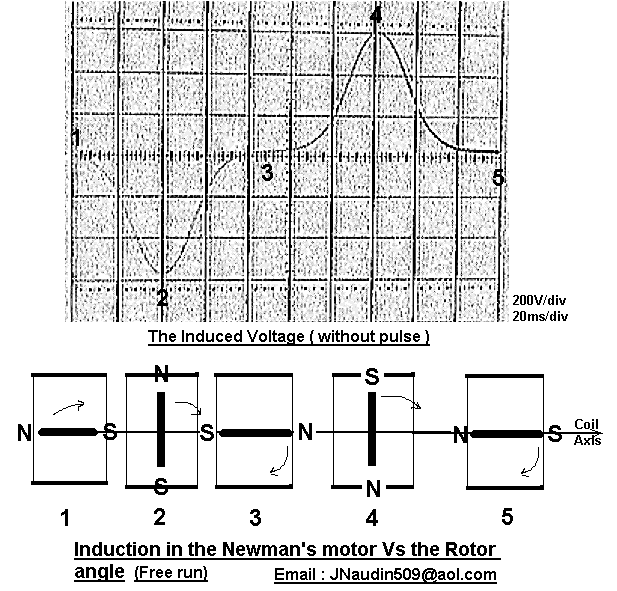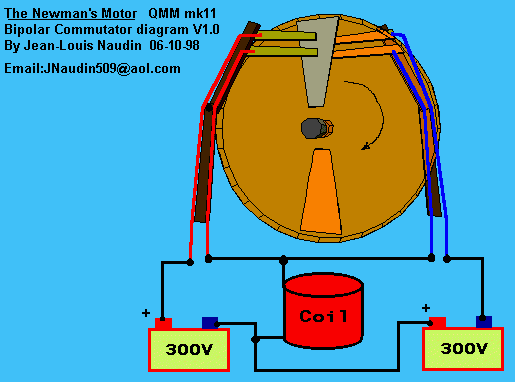
The Newman's Energy Machine V1.0
By JL Naudin/M.David
created on 06/12/98 - JLN Labs - last update on 06/18/98

The picture above shows the voltage induced in the coil without pulse (Free run).
You can notice that the voltage induced reaches its maximum when the rotating magnet is at 90 degrees from the axis of the coil (positions 2 and 4).
You can also notice that the voltage induced is null when the rotating magnet is at 0 degrees from the axis of the coil (positions 1, 3 and 5).
The "firing pulse" (when the current is sent to the coil) timing and duration depends of your initial choice :
Case 1: The Newman's machine runs as a MOTOR. In this case, all the magnetic energy will be used for producing HIGH EFFICIENCY TORQUE.
Case 2: The Newman's machine runs as a GENERATOR. In this case, all the magnetic energy will be used for producing STRONG BackEMF which RECHARGES THE BATTERY SOURCE and also produces usable electricity.
Case 3: The Newman's machine runs as a MOTOR/GENERATOR. This is the best case, but the more sophisticated for the design and the tuning of the commutator. In this case, all the magnetic energy stored in the coil and the magnetic energy from the rotating magnet will be used for producing HIGH EFFICIENCY TORQUE and also for producing STRONG BackEMF, this RECHARGES THE BATTERY SOURCE.
The Newman's Energy Machine V1.0, that I am glad to present you, has been designed only for the case 1 and 2. The case 3 can be done with an enhanced and more sophisticated commutator.
For tuning the timing of the "firing pulse" Vs the angle of the rotating magnet you must :
1) Adjust and lock the commutator wheel, so that the "contact sheets" must be parallel with the axis of the rotating magnet,
2) The phase adjustment can be finely tuned by moving left and right the arms which maintain the pair of contacts. You need to check this with an oscilloscope connected accross the coil. Be carefull of the High Voltage, the spike can reach up to 1500 Volts, so I suggest you to add a 1 Mohms resistor in series with your scope probe (you see this resistor in the picture above),
3) The Pulse duration can also be finely tuned by moving up and down the arms with the pair of contacts. So, by this mean, you will be able to adjust the pulse duration of the "firing pulse". The closer to the circumference, the shorter will be the pulse duration.
In this case, the Newman's Machine acts as a GENERATOR (see the strong backEMF spikes)
Rotor speed :
about 230 RPM, (one turn in 260 milliseconds)
Pulses duration : 30
milliseconds at 275 Volts
TWO pulses sent by turn (in opposite direction): One pulse each
180 degrees,
when the axis of the magnets are at 90 degrees from the coil
axis.
Working cycle : 26% by
turn

Some Tips for the tuning :
For the best tuning you need to add a 100 ohms resistor in series with the coil, so you will be able to measure the Voltage and the Current accross the coil.

The scope ground is connected on point C
The Current probe is connected on point B ( in reverse mode)
The Voltage probe is connected on point A
If you want the Newman's machine to run as a GENERATOR you need to adjust the firing pulse, so that the commutator is opened at the points 2 and 4 (see the "Free Run" picture above). With this tuning you get very STRONG SPARKS (see the scope picture above) and you can use this BackEmf energy for recharging the capacitor/battery.
If you want the Newman's machine to run as a MOTOR you need to adjust the firing pulse, so that the commutator is opened when the CURRENT is nullified by the magnetomotive energy resulting from the BackEmf and the Rotating magnet. So the motor will "regauge" itself each 180 degrees and will be able to give its best efficiency in mechanical power.
The preliminary tests results ( June 17, 1998 )
If you need more informations or if you have any suggestions send me your Feedback
![]() Email
: JNaudin509@aol.com
Email
: JNaudin509@aol.com
Return to the Newman's Machine Main page